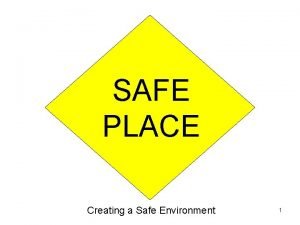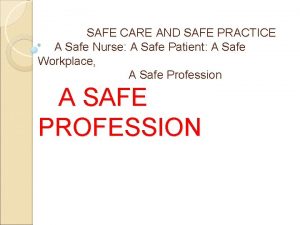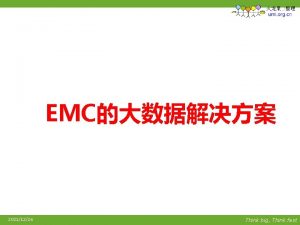So you think you are safe Going to




















- Slides: 20


So you think you are safe!

Going to Cover Threats What you can do about it Tips Questions?

Threats Internet Email Borrowed CD/DVD (including Cover Discs) Data Sticks

Hardware Firewall Unified Threat Management Device

Software Firewall Anti-Virus Anti-Spyware Anti-Spam

Malware Virus Trojan Worm Other Malware

Where, When, How will I Know Where are threats from • Russian Mafia • Triads When • Websites (upto 80% of legitimate websites are infected 1 in 150) • P 2 P Software (Limewire) How? • You may see a pop up • You may see nothing

Research by Kaspersky Lab in 2010 suggests that 1 in every how many legitimate websites is infected by malware? Percentage of Respondents 60% 50% 40% 30% 25% 20% 10% 5% 0% 12 150 275 No response

I’m Safe I use a Mac Sorry I personally don’t believe you are. • Apple’s penetration of the market • The new range of products My advice is protect your mac now, by installing a 3 rd Party Anti-Virus product

SPAM unsolicited or undesired bulk electronic messages. There are many types of electronic spam. 50 – 80 % of all emails are Spam. Possibly used as a delivery method for Viruses, worms etc. Using Bandwidth. Waste of Storage.

Percentage of emails sent in April 2011 were classified as SPAM? Percentage of Respondents 60% 50% 40% 35% 30% 20% 10% 5% 0% 16. 8% 58. 7% 72. 9% No response

Spam – what you can do! Use an effective anti – spam tool • Piece of software installed locally • Carried out at your ISP • Or through a hosted service When using an address publically, use a different address Hide email addresses in websites.

True or false – to stop receiving spam you should always click the ‘unsubscribe’ link in the email? 80% 75% Percentage of Respondents 70% 60% 50% 40% 30% 20% 15% 10% 0% TRUE FALSE No response

Physical Security Network Devices (Routers, Switches etc. ) Hard Drive Failure End Result of Virus Accidental deletion

According to IDC statistics, what percentage of businesses that suffer a major data loss cease trading within 12 months? 50% Percentage of Respondents 45% 40% 35% 30% 25% 20% 15% 15% 10% 5% 0% Up to 30% Up to 50% Up to 70% No response

Any Questions?

Regular Maintenance • • • These measure can be thought of those similar to the ones we carry out on our cars (checking lights, fluid levels etc. ) Get information about what's new Sign up to receive notification when patches are available for the software you have installed. You can usually do this by going to the manufacturer's Web site. Register new software. Software publishers can keep you informed about patches and updates. You can opt in or opt out of other services they offer. Subscribe to free Microsoft product security bulletins. Microsoft offers an e-mail alert service for home users, as well as one for IT Professionals and others with a strong understanding of technical issues. (http: //www. microsoft. com/technet/security/bulletin/notify. mspx) Install software updates immediately.

Regular Maintenance (Weekly) • Back up your files. Backing up files helps you protect your information from accidental erasure or from a hardware failure, as well as from damage by hackers. The more virulent types of attacks damage or infect your hard drive and you can lose valuable personal information. When you back up your files, make sure you: – – • • • Have a recent backup before installing new software programs or updates. Use at least a couple of storage disks, to cut down on the risk of one disk becoming damaged or infected. Write the backup date on the label. Verify that you can read the backup disk. Do store your backup disks away from your computer. If content is irreplaceable, consider a fireproof box or a safe deposit box. Let your antivirus software scan your files. Schedule your antivirus software to conduct weekly scans. It can scan data files, executable files, and system files in any combination. If an infection is found, the antivirus software will repair or quarantine specific files. Contact your antivirus vendor's Web site for further clean-up instructions. Check for software and antivirus signature updates. Software programs for which you are not receiving automatic updates or notifications, check the software publishers' Web sites. Defragment your Hard Disk. Use the built in Disk defragmenter or a third party utility to keep your hard drives contents organised, and help improve the drives performance.

Regular Maintenance (6 Monthly) • • Change your passwords. Keeping the same passwords increases the likelihood that someone else will discover your password. (See http: //www. microsoft. com/protect/yourself/password/create. mspx) Verify that your antivirus subscription is current. Treat it like car insurance. Don't let it lapse. Reassess your situation. Your security and privacy needs might have changed due to who is using your computer, how it's being used, or new threats on the Internet. Tip: Use the Windows Task Scheduler to schedule routine file maintenance such as automatic disk cleanup, disk defragmenter, and virus scans. Check the Windows Help files for instructions. Automate your maintenance tasks Computers are good at this! For example, if you are using Windows XP, Windows Me, or Windows 2000 SP 3, you can receive automatic alerts about updates needed to help maintain security and improve operation. Contact your software vendors to see what automated services they provide
 Mikael ferm
Mikael ferm Tic tac toe going high going low going criss cross lollipop
Tic tac toe going high going low going criss cross lollipop Dhirubhaism
Dhirubhaism If you are going through hell, keep going
If you are going through hell, keep going Safe feed safe food
Safe feed safe food Safe people safe places
Safe people safe places If you think you can you can poem
If you think you can you can poem Think said the robin think said the jay
Think said the robin think said the jay Think fam think
Think fam think Where are you going where have you been true story
Where are you going where have you been true story Hawk roosting annotations
Hawk roosting annotations Have a daughter so you can argue
Have a daughter so you can argue Read and choose the correct answer
Read and choose the correct answer Alan and susie an argument
Alan and susie an argument Minecraft facts
Minecraft facts What do you think of when you hear the word family
What do you think of when you hear the word family You have more potential than you think
You have more potential than you think What makes plants grow
What makes plants grow What do you think of when you hear
What do you think of when you hear You can argue
You can argue External conflict
External conflict




































